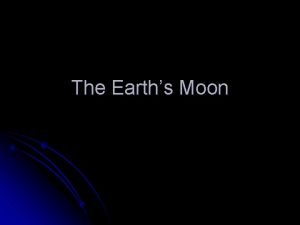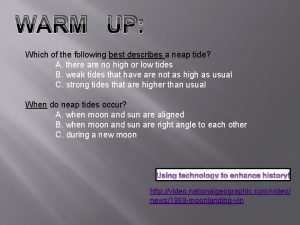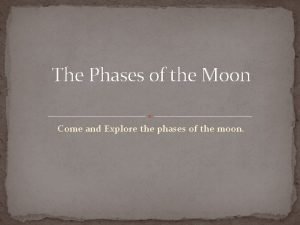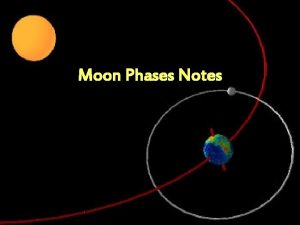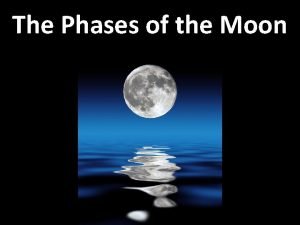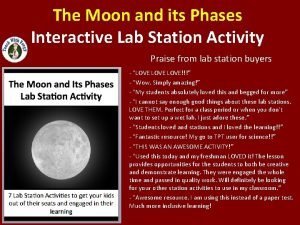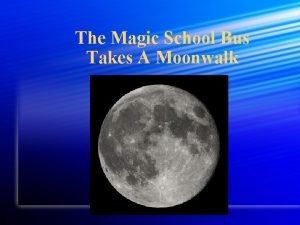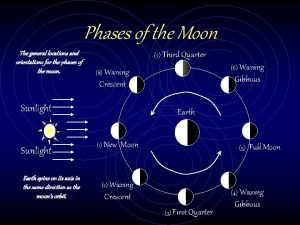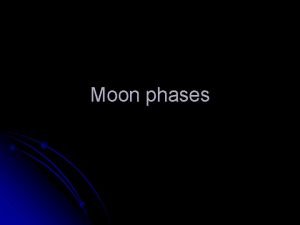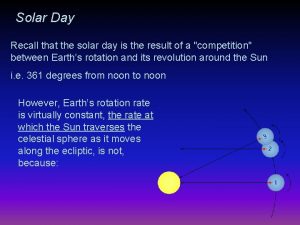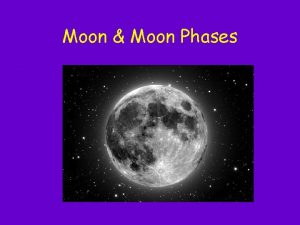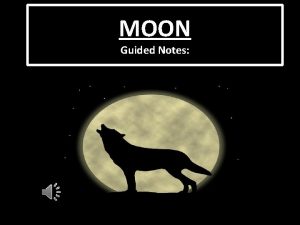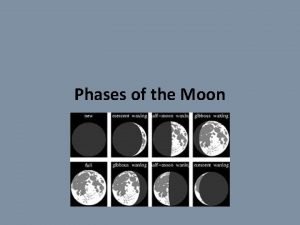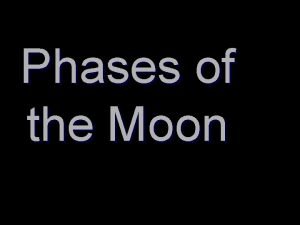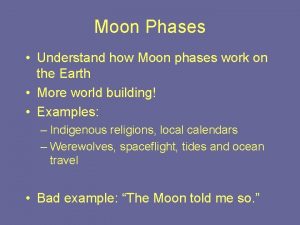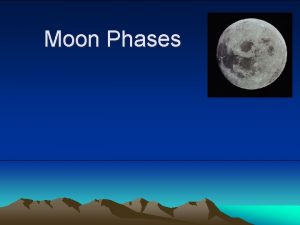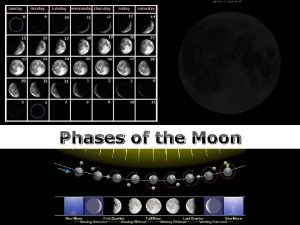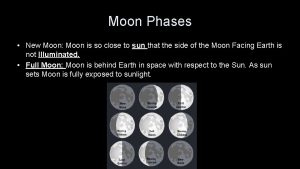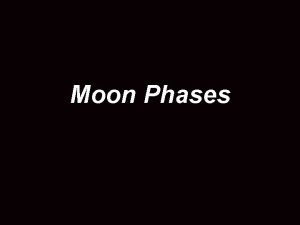Phases of the Moon Phases of the Moon











- Slides: 11

Phases of the Moon

Phases of the Moon New Moon - when the moon's disk is dark (and invisible to us) because the moon is between the sun and the Earth Crescent Moon - when we can see only a sliver of the moon's disk (the side of the moon facing us) Quarter Moon - (also called half moon) when we can see one half of the moon's disk (this is one-quarter of the entire moon's surface) Gibbous Moon - when we can see roughly three-quarters of the moon's disk Full Moon - when the moon's disk is light because the Earth is between the sun and the moon Half Moon - (also called quarter moon) when we can see one half of the moon's disk (this is one-quarter of the entire moon's surface) Waning Moon - when the moon seems to be getting smaller, going from full to gibbous to half to crescent to new Waxing Moon - when the moon seems to be getting bigger, going from new to crescent to half to gibbous to full


Animation of the Moon’s Phases http: //www. amnh. org/ology/astronomy/stufftodo/moon 2. html

What is a Blue Moon? A blue moon is a phenomenon that occurs when two full moons appear in the same calendar month. Graphic borrowed from The Moon Book by Gail Gibbons The moon is full every 29 and a half days, so it’s possible to have two full moons in any month except February. On average, there is only one blue moon every 33 months. Blue Moons occur once every 2. 7 years.

Lunar Eclipse Occurs when the earth passes between the sun and the moon Photos from Science Insights Exploring Earth and Space Addison-Wesley Publishing Company, 1996 • An eclipse occurs when one object in space casts a shadow on another. • During a lunar eclipse the moon passes through the earth’s shadow. The earth’s shadow then blocks sunlight from the moon. A lunar eclipse happens when the earth’s shadow falls across a full moon.

Stages of a Total Lunar Eclipse Photo from Science Insights Exploring Earth and Space Addison-Wesley Publishing Company, 1996

Lunar Eclipse Animation http: //csep 10. phys. utk. edu/astr 161/lect/time/lunar_anim. html

How The Moon Causes Tides Ocean Graphic created by La. Reta Tabor Gravitational Pull of the Moon Low Tides Earth High Tides are rises and falls of large bodies of water like our oceans. Tides are caused by the gravitational pull between the earth and the moon. The gravitational attraction of the moon causes the oceans to bulge out in the direction of the moon as it revolves around the earth. Moon Another bulge occurs on the opposite side, since the earth is also being pulled toward the moon (and away from the water on the far side). Since the earth is rotating while this is happening, two tides occur each day.

Animation of how the moon causes tides on earth http: //www. astro. washington. edu/larson/Astro 150 b/Lectures/Earth. Mo on/tides_anim. gif

Earth and Moon EARTH Moon 1. 2. 3. 4. 5. 6. 7. Atmosphere is a combination of gases, such as water vapor and oxygen. Surface has liquid water and life Gravity is six times stronger than moon. Earth revolves around the sun in 365 days. Many landforms including mountains, river and plains. Diameter of 7, 926 miles. Fifth largest planet, third from the sun. 1. 2. 3. 4. 5. 6. 7. Little or no atmosphere. Dusty and lifeless on surface. Weak gravitational pull. Moon revolves around the earth in about 29 days. Landforms include mountains, plains, and craters. Diameter of 2, 160 miles. Natural satellite orbiting earth.
 Moon phases
Moon phases Which statement best describes a neap tide?
Which statement best describes a neap tide? Seven phases of the moon
Seven phases of the moon What causes the phases of the moon?
What causes the phases of the moon? Eight phases of the moon
Eight phases of the moon Phases of the moon notes
Phases of the moon notes During ____ phases more of the moon is visible each night
During ____ phases more of the moon is visible each night Moon phases interactive notebook
Moon phases interactive notebook Magic school bus takes a moonwalk
Magic school bus takes a moonwalk Phases of the moon
Phases of the moon Phases of the.moon
Phases of the.moon Moon phases
Moon phases
